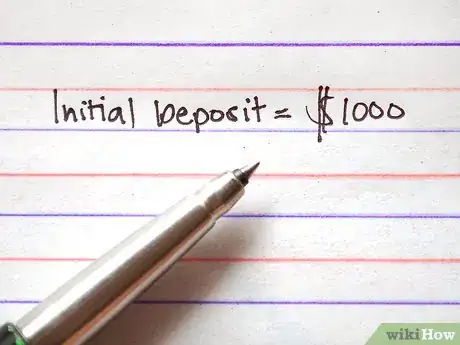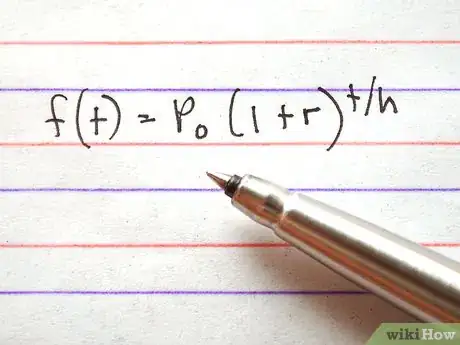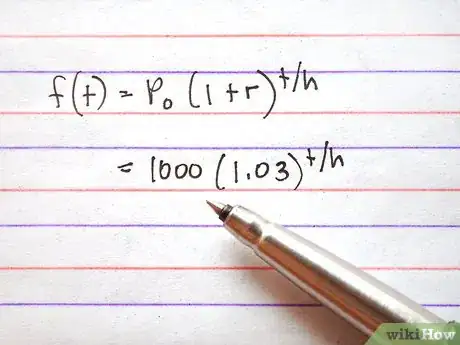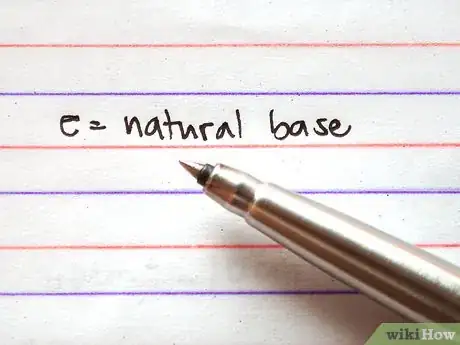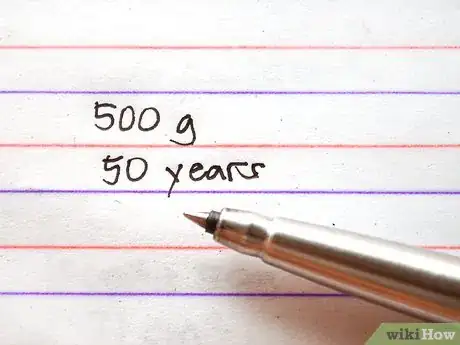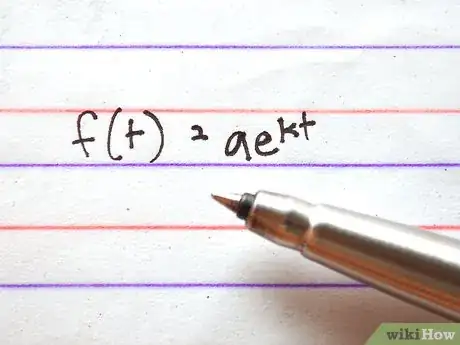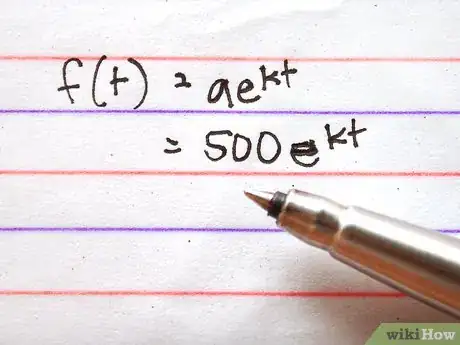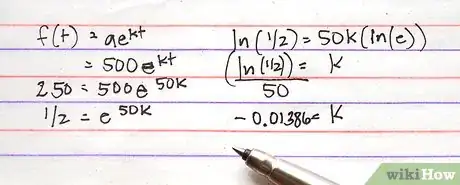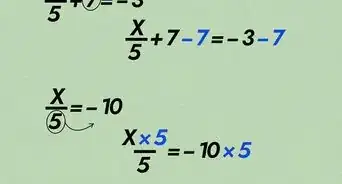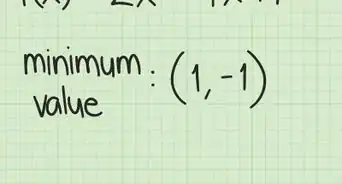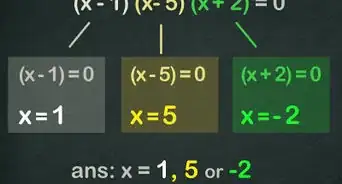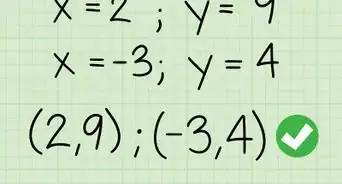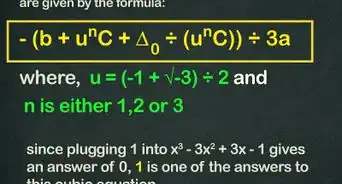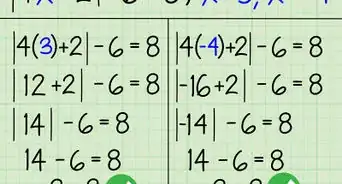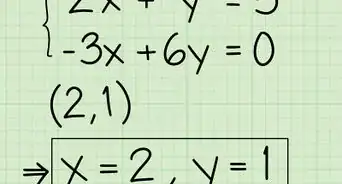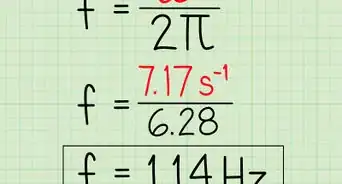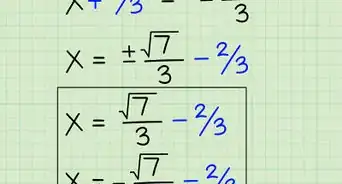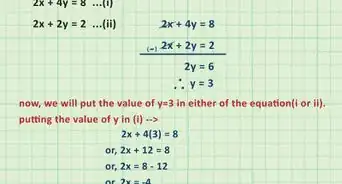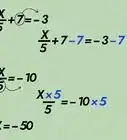wikiHow is a “wiki,” similar to Wikipedia, which means that many of our articles are co-written by multiple authors. To create this article, 21 people, some anonymous, worked to edit and improve it over time.
This article has been viewed 214,013 times.
Learn more...
Exponential functions can model the rate of change of many situations, including population growth, radioactive decay, bacterial growth, compound interest, and much more. Follow these steps to write an exponential equation if you know the rate at which the function is growing or decaying, and the initial value of the group.
Steps
Using the Rate as the Base
-
1Consider an example. Suppose a bank account is started with a $1,000 deposit and the interest rate is 3% compounded annually. Find an exponential equation modeling this function.[1]
-
2Know the basic form. The form for an exponential equation is f(t)=P0(1+r)t/h where P0 is the initial value, t is the time variable, r is the rate and h is the number needed to ensure the units of t match up with the rate.[2]Advertisement
-
3Plug in the initial value for P and the rate for r. You will have f(t)=1,000(1.03)t/h.[3]
-
4Find h. Think about your equation. Every year, the money increases by 3%, so every 12 months the money increases by 3%. Since you need to give t in months, you have to divide t by 12, so h=12. Your equation is f(t)=1,000(1.03)t/12.[4] If the units are the same for the rate and the t increments, h is always 1.
Using "e" as the base
-
1
-
2Consider an example. Suppose a 500 gram sample of an isotope of Carbon has a half life of 50 years (the half life is the amount of time for the material to decay by 50%).
-
3Know the basic form. The form for an exponential equation is f(t)=aekt where a is the initial value, e is the base, k is the continuous growth rate, and t is the time variable.
-
4Plug in the initial value. The only value you are given that you need in the equation is the initial growth rate. So, plug it in for a to get f(t)=500ekt
-
5Find the continuous growth rate. The continuous growth rate is how fast the graph is changing at a particular instant. You know that in 50 years, the sample will decay to 250 grams. That can be considered a point on the graph that you can plug in. So t is 50. Plug it in to get f(50)=500e50k. You also know that f(50)=250, so substitute 250 for f(50) on the left hand side to obtain the exponential equation 250=500e50k. Now to solve the equation, first divide both sides by 500 to get: 1/2=e50k. Then take the natural logarithm of both sides to get: ln(1/2)=ln(e50k. Use the properties of logarithms to take the exponent out of the argument of the natural log and multiply it by the log. This results in ln(1/2)=50k(ln(e)). Recall that ln is the same thing as loge and that the properties of logarithms say that if the base and the argument of the logarithm are the same, the value is 1. Therefore ln(e)=1. So the equation simplifies to ln(1/2)=50k, and if you divide by 50, you learn that k=(ln(1/2))/50. Use your calculator to find the decimal approximation of k to be approximately -.01386. Notice that this value is negative. If the continuous growth rate is negative, you have exponential decay, if it is positive, you have exponential growth.
-
6Plug in the k value. Your equation is 500e-.01386t.
Community Q&A
-
QuestionCan you help me solve this problem? "The median price P of a home rose from $100000 in 1990 to $350000 in 2010 let t be no. of years since 1990 find an equation of the form P=P0a^t"
 Community AnswerYou know that, when t=0, the price, P, is $100000. So, P0 must be 100000. Now use the second data point, when t=20. 350000=100000xa^20 (divide by 100000) 3.5 = a^20 (taking the 20th root) a=3.5^(1/20)=1.0646 which can be interpreted as an average increase of 6.46% per year.
Community AnswerYou know that, when t=0, the price, P, is $100000. So, P0 must be 100000. Now use the second data point, when t=20. 350000=100000xa^20 (divide by 100000) 3.5 = a^20 (taking the 20th root) a=3.5^(1/20)=1.0646 which can be interpreted as an average increase of 6.46% per year.
References
- ↑ https://www.cuemath.com/exponential-growth-formula/
- ↑ https://www.cuemath.com/exponential-growth-formula/
- ↑ https://www.cuemath.com/exponential-growth-formula/
- ↑ https://www.cuemath.com/exponential-growth-formula/
- ↑ https://www.mathsisfun.com/numbers/e-eulers-number.html
- ↑ https://www.purplemath.com/modules/expofcns5.htm
About This Article
To write an exponential function given a rate and an initial value, start by determining the initial value and the rate of interest. For example if a bank account was opened with $1000 at an annual interest rate of 3%, the initial value is 1000 and the rate is .03. Then, rewrite the time variable of t/h as t/12, since the money increases by 3% every 12 months. Finally, plug in the values and write your exponential function as f(t)=1,000(1.03)t/12. To learn more, including how to find the continuous growth rate from an exponential function, scroll down.
